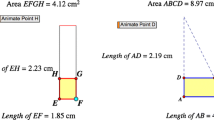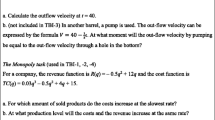Abstract
This article reports on a longitudinal observation study about students’ development in their use of procedures to calculate instantaneous rate of change. Different procedures for solving tasks on rate of change are taught in mathematics and physics classes, and together they form a repertoire. Our study took an actor-oriented perspective, which we operationalized as a search for students’ personal constructions of relationships between (1) learning from mathematics and physics classes and (2) interview tasks. We followed 10 students for 2 years (from grade 10 to 12), during which we administered 4 task-based interviews. We analyzed the breadth and connectedness of students’ repertoire of procedures and report on the long-term development thereof. We conclude that often procedures are not part of students’ repertoire shortly after the first introduction of this procedure in class. Students need time to acquire single procedures, and much more time to develop a broad and connected repertoire. In the development of their repertoire, there are major differences between students. From an actor-oriented perspective, many personal constructions are visible between learning and interview tasks. Students often use procedures that differ from procedures that are most appropriate from an expert’s perspective. We also observed from an actor-oriented perspective that words such as velocity, steepness, or slope act as bridge for creating relationships between situations and procedures.
Similar content being viewed by others
References
Anderson, J. R., Reder, L. M. & Simon, H. A. (1996). Situated learning and education. Educational Researcher, 25(4), 5–11.
Anderson, J. R., Reder, L. M. & Simon, H. A. (1997). Situative versus cognitive perspectives: Form versus substance. Educational Researcher, 26(1), 18–21.
Basson, I. (2002). Physics and mathematics as interrelated fields of thought development using acceleration as an example. International Journal of Mathematical Education in Science and Technology, 33, 679–690.
Billett, S. (2013). Recasting transfer as a socio-personal process of adaptable learning. Educational Research Review, 8, 5–13.
Creswell, J. W. (2002). Educational research: Planning, conducting, and evaluating quantitative and qualitative research. New Jersey: Merrill Prentice Hall.
Cui, L. (2006). Assessing college students’ retention and transfer from calculus to physics. Doctoral dissertation. Manhattan, KS: Kansas State University.
Goldin, G. A. (2000). A scientific perspective on structured task-based interviews in mathematics education research. In A. Kelly & R. Lesh (Eds.), Handbook of research design in mathematics and science education (pp. 517–545). Mahwah, NJ: Lawrence Erlbaum.
Greeno, J. G. (1997). On claim that answer the wrong questions. Educational Researcher, 26(1), 5–17.
Greeno, J. G., Smith, D. R. & Moore, J. L. (1993). Transfer of situated learning. In D. K. Detterman & R. Sternberg (Eds.), Transfer on trial: Intelligence, cognition, and instruction (pp. 99–167). Norwood, NJ: Ablex.
Hähkiöniemi, M. (2006). The role of representations in learning the derivative. Doctoral dissertation. Jyväskylä, Finland: University of Jyväskylä.
Hiebert, J. & Carpenter, T. P. (1992). Learning and teaching with understanding. In D. A. Grouws (Ed.), Handbook of research on mathematics teaching and learning (pp. 65–97). New York: MPC.
Karakok, G. (2009). Students’ transfer of learning of eigenvalues and eigenvectors: Implementation of the actor-oriented transfer framework. Doctoral dissertation. Corvallis: Oregon State University.
Kendal, M. & Stacey, K. (2003). Tracing learning of three representations with the differentiation competency framework. Mathematics Education Research Journal, 15(1), 22–41.
Kilpatrick, J., Swafford, J. & Findell, B. (2001). Adding it up: Helping children learn mathematics. Washington, DC: National Academy Press.
Lobato, J. (2003). How design experiments can inform a rethinking of transfer and vice versa. Educational Researcher, 32(1), 17–20.
Lobato, J. (2006). Alternative perspectives on the transfer of learning: History, issues, and challenges for future research. The Journal of the Learning of Sciences, 15, 431–449.
Lobato, J. (2012). The actor-oriented transfer perspective and its contributions to educational research and practice. Educational Psychologist, 47, 232–247.
Lobato, J. & Siebert, D. (2002). Quantitative reasoning in a reconceived view of transfer. Journal of Mathematical Behavior, 21, 87–116.
Marrongelle, K. A. (2004). How students use physics to reason about calculus tasks. School Science and Mathematics, 104, 258–272.
Mestre, J. P. (2005). Transfer of learning: from a modern multidisciplinary perspective. Greenwich, CT@@: Information Age Publishing.
Middelink, J.W. e.a. (1998). Systematische Natuurkunde N1 VWO 1. Baarn: NijghVersluys.
Nokes, T. J. (2009). Mechanisms of knowledge transfer. Thinking and Reasoning, 15(1), 1–36.
Orton, A. (1983). Students’ understanding of differentiation. Educational Studies in Mathematics, 14, 235–250.
Roorda, G. (2012). Ontwikkeling in verandering; ontwikkeling van wiskundige bekwaamheid van leerlingen met betrekking tot het concept afgeleide. [Development of ‘change’; the development of students’ mathematical proficiency with respect to the concept of derivative.] Doctoral dissertation. Groningen, The Netherlands: Rijksuniversiteit Groningen.
Roorda, G., Vos, P. & Goedhart, M.J. (2007). The concept of derivative in modelling and applications. In C. Haines, P. Galbraith, W. Blum & S. Khan (Eds.), Mathematical modelling: Education, engineering and economics (pp. 288–293). Chichester, UK: Horwood Publishing.
Roorda, G., Vos, P. & Goedhart, M.J. (2009). Derivatives and applications; development of one student’s understanding. In V. Durand-Guerrier, S. Soury-Lavergne & F. Arzarello (Eds.), Proceedings of the sixth congress of the European Society for Research in Mathematics Education. France: Lyon.
Tuminaro, J. (2004). A cognitive framework for analyzing and describing introductory students’ use and understanding of mathematics in physics. Doctoral dissertation. College Park: University of Maryland.
Yin, R. K. (2003). Case study research: Design and methods (3rd ed.). Thousand Oaks, CA: Sage Publications.
Zandieh, M. (2000). A theoretical framework for analyzing student understanding of the concept of derivative. In E. Dubinsky, A. H. Schoenfeld & J. J. Kaput (Eds.), Research in collegiate mathematics education IV (pp. 103–127). Providence, RI: American Mathematical Society.
Zandieh, M. & Knapp, J. (2006). Exploring the role of metonymy in mathematical understanding and reasoning: The concept of derivative as an example. Journal of Mathematical Behavior, 25, 1–17.
Author information
Authors and Affiliations
Corresponding author
Electronic supplementary material
Below is the link to the electronic supplementary material.
ESM 1
(DOCX 337 kb)
Rights and permissions
About this article
Cite this article
Roorda, G., Vos, P. & Goedhart, M.J. AN ACTOR-ORIENTED TRANSFER PERSPECTIVE ON HIGH SCHOOL STUDENTS’ DEVELOPMENT OF THE USE OF PROCEDURES TO SOLVE PROBLEMS ON RATE OF CHANGE. Int J of Sci and Math Educ 13, 863–889 (2015). https://doi.org/10.1007/s10763-013-9501-1
Received:
Accepted:
Published:
Issue Date:
DOI: https://doi.org/10.1007/s10763-013-9501-1




